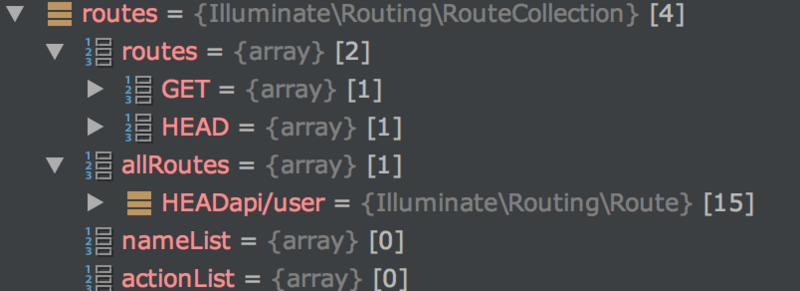前言
我的解析文章并非深層次多領域的解析攻略�。但是參考著開發(fā)文檔看此類文章會讓你在日常開發(fā)中更上一層樓。
廢話不多說��,我們開始本章的講解�����。
入口
Laravel啟動后���,會先加載服務提供者、中間件等組件�,在查找路由之前因為我們使用的是門面,所以先要查到Route的實體類��。
注冊
第一步當然還是通過服務提供者�,因為這是laravel啟動的關鍵,在 RouteServiceProvider 內(nèi)加載路由文件���。
protected function mapApiRoutes()
{
Route::prefix('api')
->middleware('api')
->namespace($this->namespace) // 設置所處命名空間
->group(base_path('routes/api.php')); //所得路由文件絕對路徑
}
首先require是不可缺少的����。因路由文件中沒有命名空間。 Illuminate\Routing\Router 下方法
protected function loadRoutes($routes)
{
if ($routes instanceof Closure) {
$routes($this);
} else {
$router = $this;
require $routes;
}
}
隨后通過路由找到指定方法,依舊是 Illuminate\Routing\Router 內(nèi)有你所使用的所有路由相關方法�����,例如get����、post、put���、patch等等��,他們都調(diào)用了統(tǒng)一的方法 addRoute
public function addRoute($methods, $uri, $action)
{
return $this->routes->add($this->createRoute($methods, $uri, $action));
}
之后通過 Illuminate\Routing\RouteCollection addToCollections 方法添加到集合中
protected function addToCollections($route)
{
$domainAndUri = $route->getDomain().$route->uri();
foreach ($route->methods() as $method) {
$this->routes[$method][$domainAndUri] = $route;
}
$this->allRoutes[$method.$domainAndUri] = $route;
}
添加后的結(jié)果如下圖所示

實例化
依舊通過反射加載路由指定的控制器,這個時候build的參數(shù)$concrete = App\Api\Controllers\XxxController
public function build($concrete)
{
// If the concrete type is actually a Closure, we will just execute it and
// hand back the results of the functions, which allows functions to be
// used as resolvers for more fine-tuned resolution of these objects.
if ($concrete instanceof Closure) {
return $concrete($this, $this->getLastParameterOverride());
}
$reflector = new ReflectionClass($concrete);
// If the type is not instantiable, the developer is attempting to resolve
// an abstract type such as an Interface of Abstract Class and there is
// no binding registered for the abstractions so we need to bail out.
if (! $reflector->isInstantiable()) {
return $this->notInstantiable($concrete);
}
$this->buildStack[] = $concrete;
$constructor = $reflector->getConstructor();
// If there are no constructors, that means there are no dependencies then
// we can just resolve the instances of the objects right away, without
// resolving any other types or dependencies out of these containers.
if (is_null($constructor)) {
array_pop($this->buildStack);
return new $concrete;
}
$dependencies = $constructor->getParameters();
// Once we have all the constructor's parameters we can create each of the
// dependency instances and then use the reflection instances to make a
// new instance of this class, injecting the created dependencies in.
$instances = $this->resolveDependencies(
$dependencies
);
array_pop($this->buildStack);
return $reflector->newInstanceArgs($instances);
}
這時將返回控制器的實例��,下面將通過url訪問指定方法��,一般控制器都會繼承父類 Illuminate\Routing\Controller ,laravel為其設置了別名 BaseController
public function dispatch(Route $route, $controller, $method)
{
$parameters = $this->resolveClassMethodDependencies(
$route->parametersWithoutNulls(), $controller, $method
);
if (method_exists($controller, 'callAction')) {
return $controller->callAction($method, $parameters);
}
return $controller->{$method}(...array_values($parameters));
}
Laravel通過controller繼承的callAction去調(diào)用子類的指定方法���,也就是我們希望調(diào)用的自定義方法。
public function callAction($method, $parameters)
{
return call_user_func_array([$this, $method], $parameters);
}
致謝
感謝你看到這里�,本篇文章源碼解析靠個人理解。如有出入請拍磚�。
以上就是本文的全部內(nèi)容��,希望對大家的學習有所幫助�,也希望大家多多支持腳本之家��。
您可能感興趣的文章:- Laravel框架源碼解析之入口文件原理分析
- Laravel框架源碼解析之反射的使用詳解
- 通過源碼解析Laravel的依賴注入
- Laravel框架學習筆記(二)項目實戰(zhàn)之模型(Models)
- laravel model模型定義實現(xiàn)開啟自動管理時間created_at,updated_at
- laravel model模型處理之修改查詢或修改字段時的類型格式案例
- Laravel5.1 框架模型工廠ModelFactory用法實例分析
- Laravel 5框架學習之模型���、控制器、視圖基礎流程
- Laravel模型事件的實現(xiàn)原理詳解
- Laravel模型間關系設置分表的方法示例
- laravel學習教程之關聯(lián)模型
- Laravel框架源碼解析之模型Model原理與用法解析